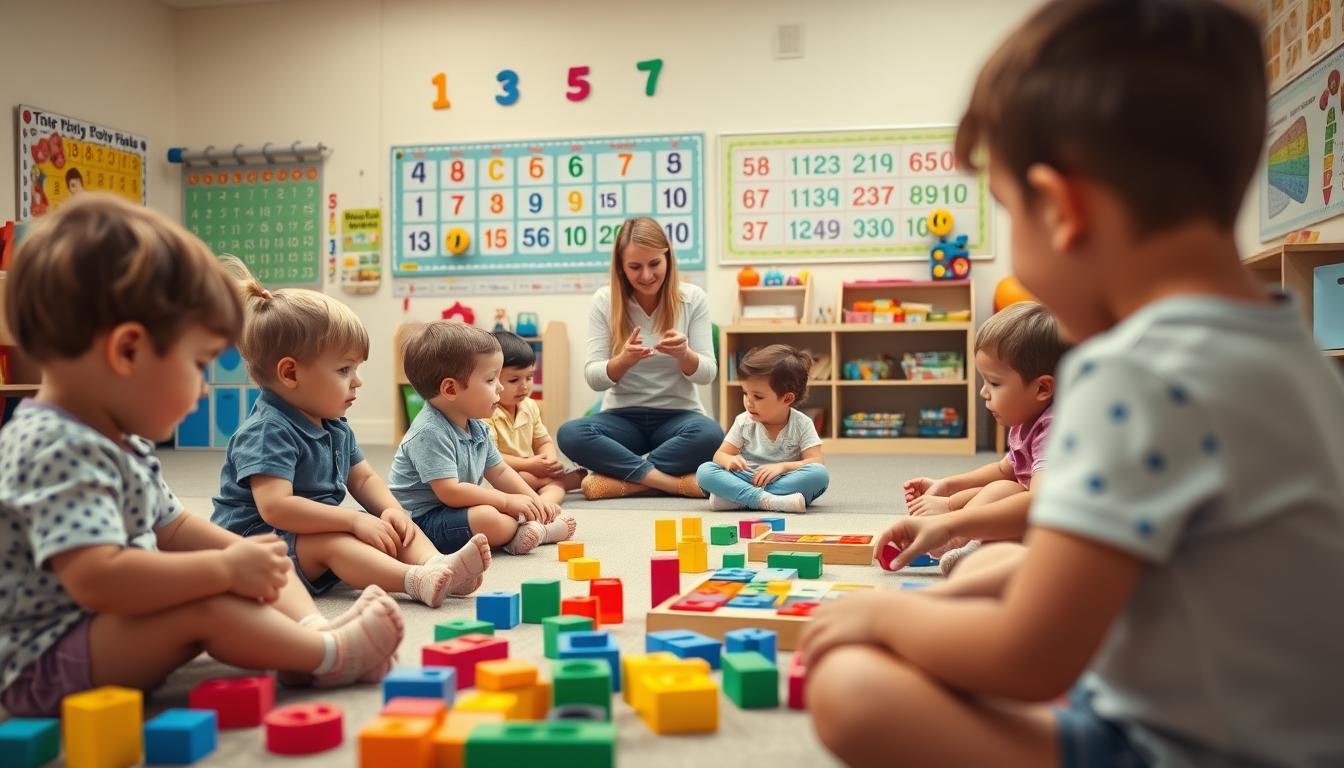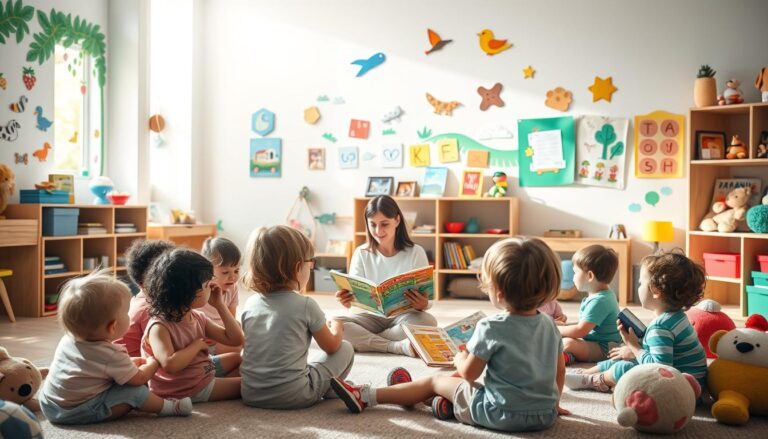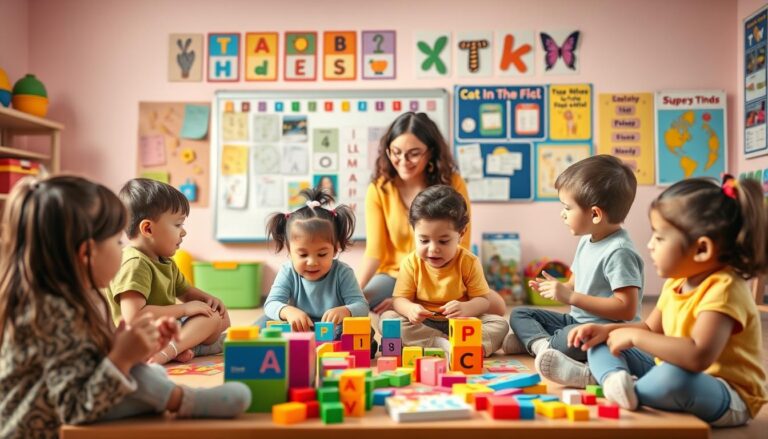Simple Math Activities for 2-Year-Olds
Did you know that children as young as two can start building foundational skills in a fun and natural way? Early exposure to concepts like counting, shapes, and patterns can set the stage for future learning. And the best part? It doesn’t require textbooks or worksheets—just everyday objects and playful interactions.
From stacking blocks to sorting toys, these simple activities help kids grasp basic ideas without even realizing they’re learning. Research shows that play-based methods are not only effective but also boost confidence and curiosity. In this article, we’ll explore how you can turn ordinary moments into opportunities for growth.
Whether it’s counting steps or identifying shapes during a walk, these methods are easy to incorporate into daily routines. Let’s dive into creative ways to make learning both engaging and meaningful for your child.
Embracing Early Math Development in Toddlers
Playful interactions with numbers can spark curiosity and growth in children. Early exposure to basic concepts like counting and shapes helps build a strong foundation for future learning. These experiences don’t have to be formal—everyday moments can become opportunities for development.
The Importance of Early Math for Growth
Introducing math concepts early supports overall cognitive development. Skills like pattern recognition and one-to-one correspondence are essential for problem-solving. Research shows that children who engage with these ideas early often perform better in school.
Simple activities, such as sorting objects by color or size, help children understand relationships between items. These tasks encourage logical thinking and decision-making. Over time, these skills become building blocks for more complex learning.
Building Confidence Through Math Play
Engaging in math-related play can boost a child’s confidence. When kids successfully count objects or identify shapes, they feel a sense of accomplishment. This positive reinforcement encourages them to explore further.
For example, using building blocks to create patterns or towers teaches spatial awareness. These activities are not only fun but also reinforce key concepts. By making learning enjoyable, we help children develop a love for exploration and discovery.
Understanding Basic Math Concepts
Early math skills begin with simple, everyday interactions that feel like play. These foundational moments help children grasp essential ideas like counting and quantity. By turning these concepts into fun experiences, we can make learning both engaging and effective.
One-to-One Correspondence in Action
One-to-one correspondence is a key skill in early learning. It involves matching each number word to a single object. For example, when a child counts three blocks, they point to each one while saying “one, two, three.”
This skill helps children understand that numbers represent specific quantities. Activities like counting toys or fruits reinforce this concept. Guiding a child’s finger over objects as they count can also improve accuracy.
Developing a Strong Number Sense
Number sense is the ability to understand and work with numbers in meaningful ways. It includes recognizing patterns, comparing quantities, and solving simple problems. Counting exercises with everyday items, like cars or puzzle pieces, build this skill naturally.
Research shows that a strong start with counting activities fosters later success in math. Interactive methods, such as number stories or structured games, make learning enjoyable. Celebrating small milestones encourages children to explore further.
Innovative Toddler Math Activities for Playful Learning
Introducing math through play can make learning a joyful experience for young children. By blending creativity with education, we can help kids explore numbers, shapes, and patterns in a way that feels natural and fun. These activities not only build foundational skills but also encourage curiosity and confidence.
Interactive shape puzzles are a great way to introduce geometry. Kids can match pieces to their corresponding slots, enhancing their understanding of different forms. Outdoor games, like counting steps or identifying shapes during a walk, combine physical activity with learning.
Technology can also play a role in math education. Simple apps designed for young learners offer engaging ways to practice counting and number recognition. However, it’s important to balance screen time with hands-on activities. Sensory bins filled with objects like beads or buttons can reinforce counting and sorting skills.
Creative play, such as building structures with blocks, teaches spatial awareness and pattern recognition. Using unconventional items like cardboard boxes or kitchen utensils can make learning even more exciting. These methods are easy to adapt for both home and classroom settings.
| Activity | Skills Developed |
|---|---|
| Shape Puzzles | Shape recognition, problem-solving |
| Outdoor Counting Games | Number sense, physical coordination |
| Sensory Bins | Counting, sorting, tactile engagement |
| Block Building | Spatial awareness, pattern creation |
For more ideas on engaging math activities, check out this resource. By incorporating these innovative methods, we can make learning math a delightful and enriching experience for every child.
Hands-On Counting and Number Recognition
Everyday objects can become powerful tools for teaching early number skills. By incorporating counting into daily routines, we can help kids build a strong foundation in a natural and engaging way. These methods not only make learning fun but also reinforce key concepts through repetition and practice.
Counting with Everyday Objects
Using household items like toys, fruits, or utensils is an effective way to introduce counting. For example, ask your child to count out loud while placing apples in a basket or stacking blocks. This hands-on approach helps them connect numbers to real-world objects.
Guiding their finger over each item as they count improves accuracy and reinforces one-to-one correspondence. Research shows that counting with familiar items boosts retention and builds confidence. These simple exercises can be seamlessly integrated into daily activities, making learning both practical and enjoyable.
Engaging with Number Stories
Storytelling is another excellent way to make numbers relatable. Create scenarios like sharing cookies or building towers with blocks. For instance, “If we have three cookies and share one, how many are left?” This bridges abstract concepts with everyday experiences.
Visual aids like counting cards or colorful pieces of paper can enhance these stories. They provide a tactile and visual way to reinforce number recognition. By connecting numbers to real-life situations, we help kids understand their practical applications.
- Use toys, fruits, or utensils for counting practice.
- Encourage kids to count out loud while handling objects.
- Incorporate number stories to make learning relatable.
- Use visual aids like counting cards for reinforcement.
For more creative ideas on early learning, explore our preschool program. These hands-on techniques not only build foundational skills but also foster a love for exploration and discovery in every child.
Exploring Shape and Pattern Play
Exploring shapes and patterns can unlock a child’s natural curiosity and creativity. These activities are not just fun but also help build essential skills like spatial awareness and logical thinking. By introducing these concepts early, we can lay a strong foundation for future learning.
Shape Sorting for Spatial Awareness
Shape sorting games are a great way to enhance spatial awareness. Kids can categorize objects by shape and color, which helps them understand relationships between items. For example, using blocks or puzzle pieces, children can match shapes to their corresponding slots.
This activity also improves fine motor skills and hand-eye coordination. Research shows that hands-on sorting tasks boost retention and confidence. By guiding kids through these exercises, we help them develop critical thinking and problem-solving abilities.
Creating Simple Patterns for Logical Thinking
Pattern creation is another effective way to foster logical thinking. Start with simple sequences like ABAB (red-blue-red-blue) or ABBABB (yellow-blue-blue-yellow-blue-blue). Use colored blocks, stickers, or even everyday objects like buttons to create these patterns.
These activities teach kids to recognize and predict sequences, which is vital for advanced concepts later on. Structured games like “Pattern Detectives” make learning engaging and interactive. By celebrating small successes, we encourage kids to explore further.
- Use shape sorting games to improve spatial awareness.
- Encourage kids to categorize objects by shape and color.
- Create simple patterns with blocks or stickers.
- Celebrate each child’s unique learning process.
Active Learning Through Kinesthetic Math Games
Active learning through movement helps kids grasp concepts while staying engaged. Kinesthetic games combine physical activity with educational goals, making learning both fun and effective. Research shows that movement-based methods can improve retention and build confidence in young learners.
Outdoor Math Explorations in Nature
Outdoor settings provide endless opportunities for hands-on learning. Kids can count leaves, rocks, or flowers while exploring nature. These activities not only reinforce counting skills but also encourage curiosity and observation.
For example, a simple scavenger hunt can involve finding specific numbers of items or identifying shapes in the environment. This approach makes learning feel like an adventure, keeping kids motivated and excited.
Fun with Building Blocks and Measuring
Building blocks are a versatile tool for teaching early skills. Kids can stack blocks to practice counting or measure structures to understand length and height. These activities introduce basic concepts like addition and spatial awareness in a playful way.
Using simple measuring tools, such as rulers or tape measures, lets kids experiment with size and quantity. This hands-on approach helps them connect abstract ideas to real-world experiences.
- Count natural objects like leaves or rocks during outdoor play.
- Combine movement with counting and shape recognition in games.
- Use blocks to introduce measurements and basic addition.
- Incorporate dice games for number recognition and physical challenges.
- Encourage tactile engagement with measuring tools for length and quantity.
Active, movement-based play reinforces math concepts while supporting motor skills development. By integrating these games into daily routines, we can make learning both enjoyable and impactful for every child.
Math in Everyday Family Life
Family routines offer a natural way to introduce math concepts to young learners. From setting the table to sorting laundry, these tasks can double as engaging learning opportunities. By weaving math into daily life, we help children see its relevance and build confidence in their abilities.
Simple activities like counting plates or matching socks by color teach foundational skills. These moments are not only practical but also reinforce key ideas like number recognition and pattern identification. The best part? They require no extra time or resources—just a little creativity.
Integrating Counting and Sorting at Home
Everyday chores can become fun math games. For example, ask your child to count the number of plates while setting the table or sort laundry by size and color. These tasks help them practice counting, sorting, and categorizing—essential skills for early learning.
Interactive games using household items are another great way to engage kids. Use playing cards to match numbers or create simple patterns with colored buttons. These activities make learning hands-on and enjoyable, fostering a positive attitude toward math.
Normalizing math in daily routines reduces stress and builds continuous learning. When children see math as part of their everyday life, they’re more likely to approach it with curiosity and confidence. Family involvement plays a key role in making these moments fun and accessible.
| Activity | Skills Developed |
|---|---|
| Setting the Table | Counting, one-to-one correspondence |
| Sorting Laundry | Sorting, categorizing, pattern recognition |
| Matching Cards | Number recognition, memory skills |
| Creating Patterns | Logical thinking, pattern identification |
For more ideas on incorporating math into daily life, explore this resource. By turning routine tasks into teachable moments, we can make learning both meaningful and enjoyable for every child.
Conclusion
Building a strong foundation for learning starts with simple, everyday moments. Throughout this article, we’ve explored how playful interactions with numbers can spark curiosity and growth in young children. From hands-on counting to dynamic games, these activities make learning both fun and meaningful.
Early exposure to basic concepts like shapes, patterns, and counting sets the stage for future success. By integrating these ideas into daily routines, we help children see the relevance of numbers in their world. Whether it’s sorting toys or exploring nature, every moment can become a teachable opportunity.
We encourage parents and educators to try these methods and adapt them to their unique environments. Celebrate small milestones and foster a love for exploration. Together, we can inspire confidence and curiosity in every child’s learning journey.
Share your experiences and success stories with us. Let’s continue making learning a joyful and enriching part of daily life.







